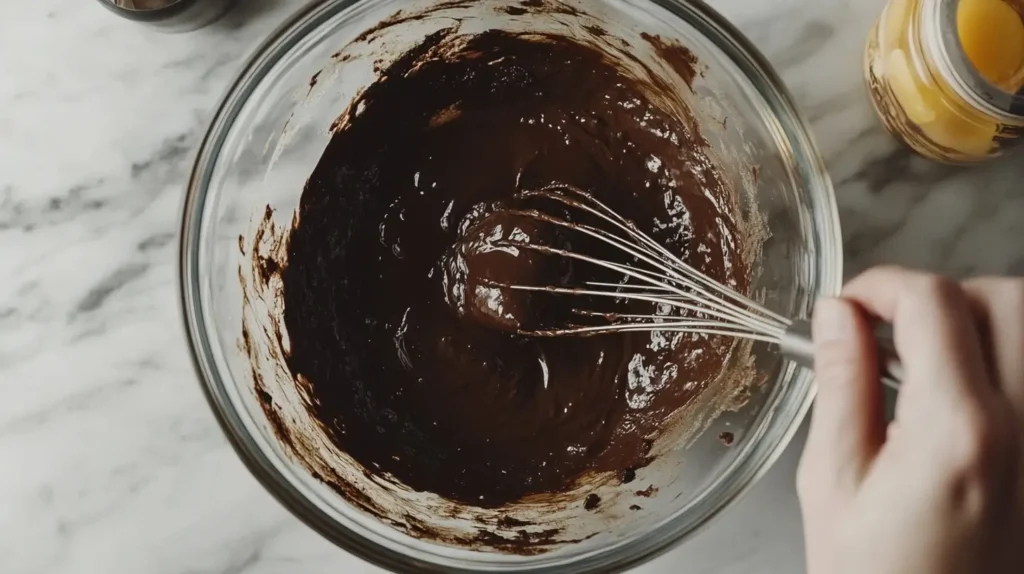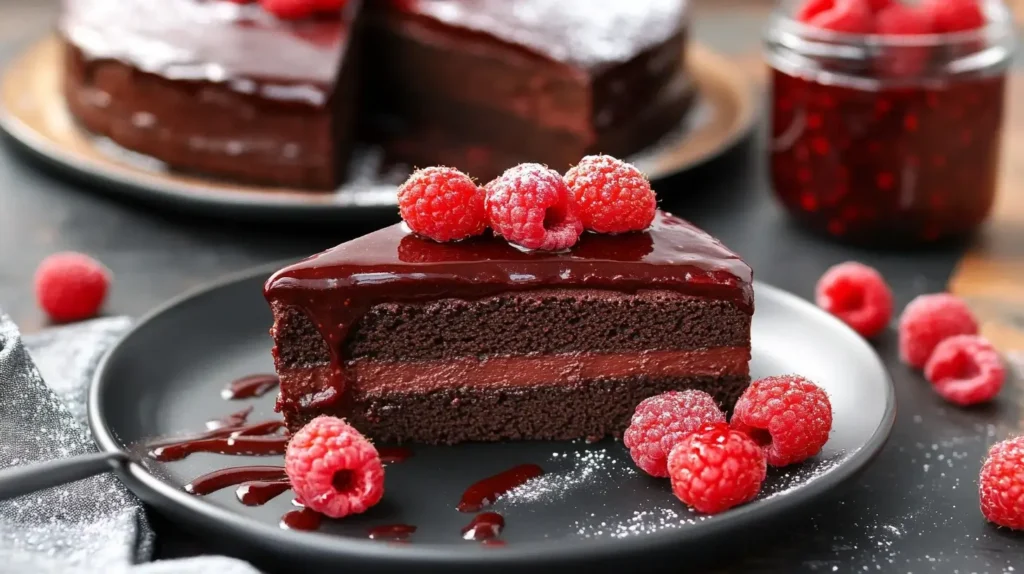Imagine biting into a rich, moist, and decadent chocolate cake, but here’s the twist—it’s 100% gluten-free! Whether you have celiac disease, a gluten intolerance, or just want to cut out gluten for health reasons, a gluten-free chocolate cake can be just as delicious (if not better) than traditional cakes.
Gluten-free baking can seem a little tricky at first. The texture, structure, and moisture balance are completely different from regular cakes. But don’t worry! With the right ingredients and techniques, you can achieve a soft, moist, and perfectly fluffy gluten-free chocolate cake that no one will even suspect is gluten-free.
In this guide, we’ll go through everything—from common challenges and solutions to step-by-step baking instructions, so you can bake a masterpiece every time!
Health Benefits of Gluten-Free Chocolate Cake
1. Suitable for People with Celiac Disease and Gluten Sensitivity
For those with celiac disease or non-celiac gluten sensitivity, consuming gluten can lead to severe digestive issues, fatigue, and inflammation. A gluten-free chocolate cake allows them to enjoy a delicious dessert without harmful side effects.
2. Easier on Digestion
Gluten-free flours, such as almond and oat flour, are often easier to digest compared to refined wheat flour. They contain more fiber, which supports gut health and improves digestion.
3. May Reduce Inflammation
For some individuals, gluten can trigger inflammatory responses in the body, leading to joint pain, bloating, or skin issues. Switching to a gluten-free cake made with anti-inflammatory ingredients like cocoa, almond flour, and coconut sugar may help reduce these effects.
4. Packed with Antioxidants from Cocoa
Dark chocolate and cocoa powder are rich in flavonoids and antioxidants, which help fight free radicals, reduce oxidative stress, and support heart health.
5. Lower in Refined Carbohydrates
Many gluten-free chocolate cakes use nut-based flours like almond or coconut flour, which are lower in carbs and higher in protein and fiber. This can help with blood sugar control and prevent energy crashes.
6. A Great Source of Healthy Fats
Gluten-free recipes often incorporate healthy fats from sources like almond flour, coconut oil, and dark chocolate. These fats are beneficial for brain function, hormone balance, and heart health.
7. Can Be Made Dairy-Free and Sugar-Free
Many gluten-free cake recipes can be adapted for those with additional dietary restrictions by using dairy-free milk (such as almond or oat milk) and natural sweeteners like maple syrup or monk fruit.
8. Helps Improve Energy Levels
Unlike traditional cakes that cause blood sugar spikes, a well-balanced gluten-free chocolate cake provides a steady release of energy, keeping you fuller for longer and reducing cravings.
Gluten-Free Chocolate Cake: Ingredients, Measurements, and Nutrition Facts
| Category | Ingredient | Quantity |
|---|---|---|
| For the Cake | Gluten-free all-purpose flour (with xanthan gum) | 1 ½ cups |
| Unsweetened cocoa powder | ¾ cup | |
| Baking powder | 1 ½ teaspoons | |
| Baking soda | ½ teaspoon | |
| Salt | ½ teaspoon | |
| Granulated sugar | 1 cup | |
| Brown sugar | ½ cup | |
| Eggs (room temperature) | 2 large | |
| Wet Ingredients | Vegetable oil or melted coconut oil | ½ cup |
| Milk (or dairy-free alternative) | 1 cup | |
| Pure vanilla extract | 1 teaspoon | |
| Hot coffee (to enhance chocolate flavor) | ½ cup | |
| For the Frosting | Unsalted butter (room temperature) | 1 cup |
| Powdered sugar | 2 ½ cups | |
| Unsweetened cocoa powder | ½ cup | |
| Salt | ½ teaspoon | |
| Vanilla extract | 1 teaspoon | |
| Milk (or dairy-free alternative) | 3–4 tablespoons |
Nutrition Facts (Per Slice)
| Nutrient | Amount |
|---|---|
| Calories | 320 kcal |
| Carbohydrates | 45g |
| Protein | 5g |
| Fat | 14g |
| Sugar | 30g |
| Fiber | 3g |
| Sodium | 180mg |
Step-by-Step Guide to Making the Best Gluten-Free Chocolate Cake

| Step | Instructions |
|---|---|
| 1️⃣ Preheat & Prepare | Preheat your oven to 350°F (175°C). Grease two 8-inch cake pans and line them with parchment paper. |
| 2️⃣ Mix the Dry Ingredients | In a large bowl, whisk together gluten-free flour, cocoa powder, baking powder, baking soda, and salt. |
| 3️⃣ Prepare the Wet Ingredients | In another bowl, beat together sugar, eggs, oil, milk, and vanilla extract until smooth. Slowly add hot coffee while stirring. |
| 4️⃣ Combine the Batter | Gradually add the dry ingredients into the wet mixture. Stir until just combined—do not overmix! |
| 5️⃣ Bake the Cake | Divide the batter evenly between the two pans. Bake for 28–32 minutes or until a toothpick comes out with a few moist crumbs. |
| 6️⃣ Cool Completely | Let the cakes cool in the pans for 10 minutes, then transfer to a wire rack to cool completely before frosting. |
| 7️⃣ Make the Frosting | In a bowl, beat butter until fluffy. Add powdered sugar, cocoa powder, salt, and vanilla. Mix in milk until smooth. |
| 8️⃣ Assemble the Cake | Spread frosting over the first cake layer. Place the second layer on top and frost the top and sides evenly. |
| 9️⃣ Decorate & Serve | Garnish with chocolate shavings, berries, or a dusting of cocoa powder. Slice and enjoy your gluten-free chocolate cake! |
Common Problems and How to Fix Them
Why Did My Gluten-Free Chocolate Cake Turn Out Gummy?
A gummy texture in gluten-free cakes usually happens when:
- Too much liquid is used.
- The batter was overmixed, leading to excess starch breakdown.
- Only one type of gluten-free flour was used (instead of a blend).
Solution: Reduce excess moisture by slightly decreasing liquid ingredients. Mix the batter gently—stop as soon as everything is combined. Also, try using a combination of rice flour, almond flour, and starches instead of relying on just one flour.
How to Prevent a Dry and Crumbly Cake
Gluten-free cakes often end up dry because:
- There’s not enough fat or liquid.
- They were baked too long.
- Flour-to-liquid ratios were incorrect.
Solution: Increase moisture by adding an extra egg, applesauce, or yogurt to the batter. Make sure to check the cake a few minutes before the suggested baking time.
Troubleshooting a Cake That Won’t Rise Properly
If your cake turned out dense or flat, it could be because:
- The leavening agents (baking powder/soda) were expired.
- The batter was overmixed, making it too heavy.
- Too much liquid made the cake too dense.
Solution: Use fresh baking powder and baking soda. Mix the batter gently, just until ingredients are combined. Also, make sure to measure liquid ingredients carefully.
Expert Tips for Perfect Gluten-Free Chocolate Cake Every Time
1. Always Use Room-Temperature Ingredients
Cold ingredients (like eggs and milk) can cause an uneven batter and affect the texture. Always let your ingredients come to room temperature before mixing.
2. Sift Your Dry Ingredients
Gluten-free flours tend to clump together. Sifting removes lumps and aerates the flour, making your cake lighter and fluffier.
3. Let the Batter Rest Before Baking
Gluten-free batters benefit from resting for about 15 minutes. This allows the flours to absorb moisture, reducing grittiness.
4. Don’t Open the Oven Door Too Soon
Gluten-free cakes are delicate. If you open the oven too early, they might collapse. Only check for doneness in the final 5 minutes.
5. Use a Water Bath for Extra Moisture
Place a pan of hot water on the bottom rack of your oven while baking. This keeps the air moist, preventing dryness.
6. Always Cool Completely Before Frosting
Warm cakes will melt frosting and create a mess. Let the cake cool for at least 1 hour before decorating.
7. Experiment with Different Gluten-Free Flour Ratios
Different flours yield different textures. Play around with combinations like:
- 50% oat flour + 30% almond flour + 20% tapioca starch (moist & fluffy)
- 60% rice flour + 40% coconut flour (light & airy, but drier)
8. Add a Secret Ingredient for Extra Moisture
Try adding 1/4 cup of unsweetened applesauce or Greek yogurt to your batter. It keeps the cake moist without affecting the flavor.
Decorating and Serving Ideas for Gluten-Free Chocolate Cake
Best Frosting Options: Dairy-Free, Vegan, or Sugar-Free
The right frosting can take your cake to the next level! Here are some options:
- Classic Chocolate Buttercream: A rich and creamy option made with butter, cocoa, and powdered sugar.
- Dairy-Free Frosting: Swap out butter for coconut oil or vegan butter.
- Sugar-Free Frosting: Use monk fruit sweetener or erythritol instead of powdered sugar.
Simple and Elegant Garnishing Tips

- Chocolate shavings for a luxurious touch.
- Fresh berries (strawberries, raspberries) for color and tartness.
- Drizzle with melted dark chocolate for extra richness.
- A dusting of cocoa powder for a refined look.
Pairing Your Cake with the Perfect Drinks
- Espresso or black coffee: A bold contrast to the sweet cake.
- Almond or oat milk: A creamy complement.
Gluten-Free Chocolate Cake Storage and Shelf Life
How to Keep Your Cake Fresh for Longer
- Store at room temperature in an airtight container for up to 3 days.
- Keep in the refrigerator for up to a week.
Can You Freeze a Gluten-Free Chocolate Cake?
Yes! Here’s how:
- Wrap slices in plastic wrap, then place them in an airtight container.
- Freeze for up to 3 months.
- Thaw overnight in the refrigerator before serving.
Frequently Asked Questions (FAQ)
Can I Use Regular Chocolate in a Gluten-Free Cake?
Yes! Most high-quality dark chocolates (70% or more) are naturally gluten-free. Always check the label to be sure.
What’s the Best Store-Bought Gluten-Free Flour for Cakes?
Some great options include:
- Bob’s Red Mill Gluten-Free 1-to-1 Baking Flour
- King Arthur Gluten-Free Measure for Measure Flour
- Pamela’s All-Purpose Gluten-Free Flour
How Can I Make My Cake Less Dense?
Use a mix of lighter flours like oat flour and rice flour instead of just almond flour. Also, don’t overmix the batter, and make sure your baking powder is fresh.
Conclusion: Enjoying a Delicious Gluten-Free Chocolate Cake Without Compromise
Now you have everything you need to bake the best gluten-free chocolate cake—from the perfect flour blend to frosting and storage tips. With the right ingredients and techniques, you can make a cake so delicious that even gluten lovers will ask for seconds!
For those who love indulging in gluten-free desserts, why stop at chocolate cake? Try this deliciously rich and creamy treat next—learn How to Make the Best Chocolate Chip Ricotta Cake (Gluten-Free & Easy!)!

